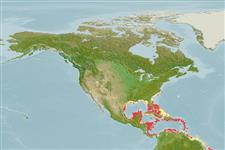Common names from other countries
>
Anguilliformes (Eels and morays) >
Chlopsidae (False morays)
Etymology: Kaupichthys: Because of Johann Jakob Kaup, 1827; author of "Zoologische Monographien", ichthyologist + Greek, ichthys = fish.
Environment: milieu / climate zone / depth range / distribution range
Ecología
marino asociado a arrecife. Tropical
Western Atlantic: Texas, USA and the Bahamas to the Antilles (Ref. 26340) and northern South America. Northwestern Gulf of Mexico to Caribbean (Ref. 26938).
Tamaño / Peso / Age
Maturity: Lm ? range ? - ? cm
Max length : 16.0 cm TL macho / no sexado; (Ref. 7251)
Moderately slender eel, with pale band around head behind eye (Ref. 26938).
A benthic and solitary species (Ref. 26340) occurring in and around coral reefs. Sometimes lives in tubular sponges, and suggested that this is its primary habitat (Ref. 26938).
Life cycle and mating behavior
Maturities | Reproducción | Spawnings | Egg(s) | Fecundities | Larva
Robins, C.R. and G.C. Ray, 1986. A field guide to Atlantic coast fishes of North America. Houghton Mifflin Company, Boston, U.S.A. 354 p. (Ref. 7251)
IUCN Red List Status (Ref. 130435)
CITES (Ref. 128078)
Not Evaluated
Threat to humans
Harmless
Human uses
Herramientas
Special reports
Download XML
Fuentes de Internet
Estimates based on models
Preferred temperature (Ref.
115969): 25.5 - 28.2, mean 27.4 (based on 635 cells).
Phylogenetic diversity index (Ref.
82804): PD
50 = 0.5156 [Uniqueness, from 0.5 = low to 2.0 = high].
Bayesian length-weight: a=0.00102 (0.00046 - 0.00225), b=3.06 (2.88 - 3.24), in cm Total Length, based on all LWR estimates for this body shape (Ref.
93245).
Nivel trófico (Ref.
69278): 3.7 ±0.6 se; based on size and trophs of closest relatives
Fishing Vulnerability (Ref.
59153): Low vulnerability (10 of 100).
